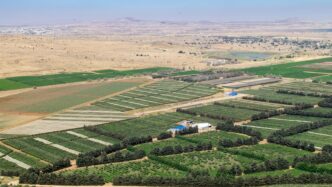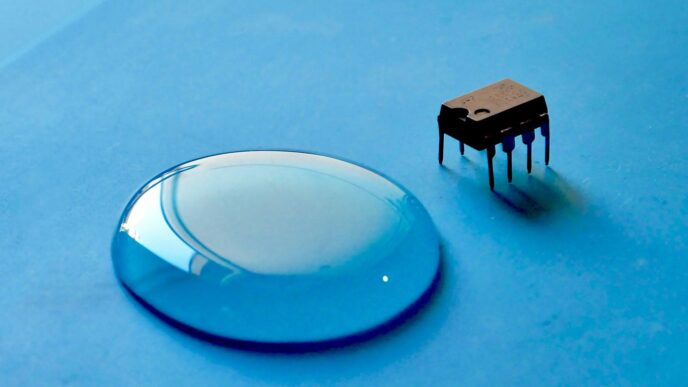It’s pretty amazing what Israel has accomplished when it comes to farming, especially considering how little water they have. For years, they’ve been facing serious water shortages, but instead of giving up, they’ve come up with some really clever ways to grow food. This agriculture technology in Israel isn’t just about fancy gadgets; it’s about smart thinking and making every drop count. From inventing drip irrigation to figuring out how to use water that most places would just throw away, Israel is showing the world how to farm sustainably, even in tough, dry conditions. It’s a story of necessity really driving some incredible innovation.
Key Takeaways
- Israel’s pioneering drip irrigation systems deliver water straight to plant roots, drastically cutting down on waste compared to older methods.
- They’ve become experts at using water sources that were once considered unusable, like treated wastewater and even slightly salty water, for farming.
- Advanced sensors and smart technology help farmers know exactly when and how much to water, preventing over-watering and saving resources.
- Through plant breeding, Israeli scientists have developed crops that can handle dry spells and salty soil much better.
- Israel actively shares its water-saving farming knowledge and technology with other countries through training and partnerships.
Pioneering Drip Irrigation For Arid Lands
Necessity Drives Innovation In The Negev
Living in the Negev desert, where rain is scarce and the soil can be salty, really forces you to get creative with water. Back in the day, folks at Kibbutz Hatzerim were struggling. They had this sandy, salty soil, and the usual farming methods just weren’t cutting it. Crops looked okay, but they didn’t produce much. It was tough going, and some people even left because of it. They needed a way to farm that didn’t rely on drenching the whole field, especially when water was piped in from far away and was pretty expensive.
Direct Root Zone Delivery
This is where the idea for drip irrigation really took off. The story goes that an engineer named Simcha Blass noticed a tree growing way better than others nearby. Turns out, a leaky pipe was slowly dripping water right to its roots. That simple observation sparked a big idea: what if we could control exactly where the water goes? Instead of flooding fields and hoping for the best, drip systems deliver water and nutrients straight to the plant’s root zone. This means less water is wasted on evaporation or running off into places it’s not needed. It’s like giving each plant a personal drink, right where it needs it most.
- Minimizes evaporation: Less water lost to the hot desert air.
- Reduces runoff: Water stays put, preventing soil erosion.
- Precise nutrient delivery: Fertilizers can be mixed with the water and sent directly to the roots.
- Works with salty soil: The concentrated watering can help create a less salty zone around the roots.
Maximizing Water Use Efficiency
Before drip irrigation, a lot of water used in farming just disappeared into thin air or soaked into the ground where it couldn’t help the plants. We’re talking about 80% of agricultural water being used conventionally, and half of that not even reaching the crops. That’s a huge waste, especially when water is so precious. Drip systems changed the game. By delivering water right to the roots, they can use significantly less water – sometimes up to 70% less – compared to older methods like flood irrigation. This efficiency is a lifesaver in dry places. It means farmers can grow more with less, making agriculture viable even in tough, arid conditions. It’s not just about saving water; it’s about making sure every drop counts for the plants that need it.
Advanced Water Management And Reuse Strategies

Israel’s journey with water scarcity has really pushed them to get creative. They’ve figured out how to make the most of what they have, and honestly, it’s pretty impressive. It’s not just about using less water; it’s about finding new sources and making sure every drop counts.
Leveraging Saline And Non-Conventional Water Sources
When you live in a place like Israel, you can’t afford to be picky about water. They’ve gotten really good at using water that most places would just consider a problem. This includes things like treated wastewater and even slightly salty water. The idea is to take water that’s not ideal for drinking and make it work for farming. It’s a smart way to keep crops growing without draining precious freshwater supplies.
Wastewater Treatment For Agricultural Sustainability
This is a big one. Israel recycles a huge amount of its wastewater – we’re talking close to 90 percent, which is the highest in the world. A prime example is the Shafdan facility near Tel Aviv. It takes urban wastewater, cleans it up, and then puts it back into the ground. This treated water is then used for farming. It’s a closed-loop system that turns waste into a reliable resource. This approach not only provides a steady water supply for farmers, even during dry spells, but it also helps protect underground water sources from getting overused or contaminated.
Managed Aquifer Recharge For Water Security
Managed Aquifer Recharge, or MAR, is another clever trick. It’s basically a way to store water underground. In Israel, they use it with treated wastewater. After the water is treated, it’s put back into aquifers. This does a couple of things. First, the ground acts as a natural filter, cleaning the water even further. Second, it helps keep the water table stable and stops saltwater from creeping into freshwater sources, which is a big issue in coastal areas. This makes sure there’s a secure water supply for agriculture, year after year.
Precision Agriculture Technologies
Root-Zone Moisture Sensing For Optimized Irrigation
Forget guessing when your plants are thirsty. Israeli tech has gotten really good at figuring out exactly what’s happening right down at the root level. We’re talking about sensors that get stuck right into the soil, telling farmers in real-time how much moisture is actually there. This is a huge step up from just looking at the surface or relying on a timer that might water too much or too little. By knowing the precise moisture content, farmers can water only when and where it’s needed. This means less water wasted by soaking too deep into the ground or running off the surface. Studies have shown that using these systems can save anywhere from 20% to 50% of water, and the crops don’t suffer – in fact, they often do better because they get just what they need. Plus, keeping the soil moisture steady helps plants absorb nutrients better, which might even mean using less fertilizer.
AI-Integrated Platforms For Predictive Watering
Now, things get even more interesting when you add artificial intelligence into the mix. Israeli companies are developing platforms that don’t just tell you what’s happening now, but try to predict what your plants will need in the future. These systems look at a bunch of different things: weather forecasts, what happened in past growing seasons, satellite images of the fields, and even how the plants themselves are growing. By crunching all this data, the AI can suggest irrigation schedules that are tailored to specific crops, soil types, and even tiny differences in climate across a farm. The idea is to get ahead of the curve, so you’re watering proactively, not reactively. It’s like having a super-smart assistant who knows your farm inside and out. While these advanced systems are really promising, especially for large farms or areas with very little water, it’s still a bit of a question mark for smaller farms. Sometimes, the extra savings from AI might not be enough to cover the cost, especially when simpler sensor systems are already doing a pretty good job. But the technology is getting smarter all the time, and the interfaces are becoming easier to use.
Real-Time Data For Responsive Farming
Putting all this data to work is where the real magic happens. With sensors in the ground and AI analyzing the information, farmers can make quick, smart decisions. Imagine getting an alert on your phone that says, "Hey, the corn in field three needs a bit more water tomorrow morning," or "The tomatoes are showing early signs of stress, adjust the irrigation schedule." This kind of immediate feedback allows for a farming approach that’s constantly adapting. It’s a far cry from the old days of setting it and forgetting it. This responsiveness means that water and nutrients are used much more effectively, leading to healthier plants and better yields. It also means that farmers can manage their resources much more efficiently, which is a big deal when water is scarce. The systems are often connected wirelessly, so you can monitor everything from anywhere, making it easier to keep an eye on things even when you’re not physically in the field.
Innovative Plant Breeding For Resilience
So, you’ve got the fancy irrigation systems and the smart sensors, but what about the plants themselves? Turns out, Israel has been doing some pretty neat work here too, focusing on making crops tougher and more water-wise. It’s not about messing with genes in a lab, but more about smart selection and breeding. Think of it like picking the best seeds from your garden year after year to get stronger plants.
Developing Salt-Tolerant And Drought-Resilient Varieties
This is a big one, especially when you’re dealing with land that’s not exactly prime real estate. Israeli scientists have been working hard to develop plants that can actually handle salty water and dry spells. They’ve figured out how to grow crops in places that used to be considered too harsh for farming. This means areas with brackish water or very little rainfall can actually become productive. It’s pretty amazing when you think about it – turning deserts and salty coastlines into viable farmland.
Enhancing Crop Efficiency Through Genetic Selection
Here’s where it gets really interesting. Why waste water and fertilizer on parts of the plant we don’t even eat? Israeli researchers have been breeding plants that are more efficient. For example, they’ve developed tomato plants with shorter root systems and fewer leaves, or wheat plants with shorter stalks. The idea is simple: concentrate the water and nutrients where they matter most – on the edible parts. This approach cuts down on waste significantly.
Focusing Water And Nutrient Use On Edible Parts
This ties right into the last point. Instead of just letting a plant grow wild with big leaves and deep roots that don’t contribute to our food, the focus is on optimizing for yield. It’s about making sure that every drop of water and every bit of fertilizer goes towards producing more fruit, grain, or vegetables. This kind of targeted breeding means you get more food with fewer resources. It’s a practical, no-nonsense way to farm more sustainably.
Global Technology Transfer And Capacity Building
It’s one thing to invent amazing water-saving tech, but it’s another thing entirely to get it used by farmers all over the world, especially in places that really need it. Israel has learned a lot about this over the years. They’ve figured out that just sending over fancy equipment doesn’t cut it. You have to work with people, train them, and make sure the solutions actually fit their local situation.
Partnerships For Scalable Solutions
Getting these technologies out there often involves working with others. Think of it like a team effort. Israeli companies, government agencies like MASHAV, and local groups in other countries team up. These partnerships can help make sure the tech is affordable and practical for farmers. Sometimes, local governments will help out with land or infrastructure, which makes a big difference. It’s not just about selling a product; it’s about building something that lasts.
Farmer Training In Water-Efficient Methods
This is a big one. Farmers need to know how to use the new systems. So, lots of training programs have popped up. They teach farmers about things like drip irrigation, how to read soil moisture sensors, and how to manage water better overall. Sometimes, they even train the trainers – local folks who can then go out and teach even more farmers. It’s like a ripple effect, spreading knowledge far and wide.
Demonstration Farms For Local Adaptation
Seeing is believing, right? That’s where demonstration farms come in. These are places where farmers can actually see the technology working in their own area, under their own weather conditions. It builds trust and shows them firsthand how much water they can save and how it can help their crops. These farms are key for adapting the technology to fit the specific needs of different regions. It’s about making sure the solutions work on the ground, not just in a lab.
Financing Models For Water-Saving Agri-Tech
So, how do you actually pay for all this smart water tech? It’s not always cheap upfront, and getting farmers, especially smaller ones, to adopt new systems can be tough. Israel has figured out a few ways to make it work, and these ideas are starting to spread.
Impact Investing And Blended Finance
This is where money from people who want to do good and make a profit comes in. Think of it as mixing private money with public or charity funds. It’s a way to get bigger projects off the ground that might not look like a sure bet to traditional investors right away. These investors are looking for a win-win: good returns and a positive impact, like saving water or helping farmers deal with dry spells. It’s a growing area, and it’s helping fund some really interesting water-saving projects.
Incentives For Water Conservation
Sometimes, you just need a little nudge. Local governments can offer things like tax breaks or subsidies to farmers who invest in water-saving tech. There are also models where farmers get paid if they can prove they’ve saved water or gotten better yields. It’s all about making the switch financially sensible. These incentives help bridge the gap between the cost of new technology and the long-term benefits.
Carbon-Linked Irrigation Credits
This is a newer idea, but it’s pretty clever. When farmers use less water, especially water that needs to be pumped using electricity, they’re also cutting down on carbon emissions. The idea is to create credits for these emission reductions, which farmers could then sell. It’s not widespread yet, but it could open up a whole new income stream for farmers who are already doing their part to conserve water and energy.
Looking Ahead: Israel’s Water Wisdom for a Thirsty Planet
So, what’s the big takeaway from all this? Israel’s journey with water scarcity has turned necessity into a real advantage. They’ve shown the world that farming in dry places isn’t just possible, it can be incredibly productive. From making salty water work for crops to recycling nearly all their wastewater, they’ve built a whole system. It’s not just about fancy gadgets, though they have those too, like smart irrigation that talks to the soil. It’s also about smart policies and sharing what they’ve learned. As other parts of the world face similar water challenges, Israel’s practical, tested methods offer a hopeful path forward, proving that innovation and careful management can help feed a growing population, even when the rain doesn’t fall.
Frequently Asked Questions
How did Israel become a leader in farming technology despite having so little water?
Israel faced extreme water shortages for years. This difficulty forced them to get creative and invent new ways to farm with very little water. They developed technologies like drip irrigation, which waters plants right at their roots, and found ways to clean and reuse wastewater for farming. It shows that when you really need something, you can invent amazing solutions!
What is drip irrigation and why is it so important?
Drip irrigation is a smart way to water plants. Instead of flooding a whole field, it sends water slowly and directly to the roots of each plant through tiny tubes or drippers. This means much less water is wasted because it doesn’t evaporate into the air or soak into the ground where plants can’t reach it. It’s like giving each plant a personal drink exactly when it needs it.
Can farms really use treated wastewater for crops?
Yes, absolutely! Israel is a world leader in cleaning and reusing wastewater for farming. After going through advanced treatment, the water is clean enough to be used on crops. This is a brilliant way to save precious freshwater resources and ensure farms have enough water, even when there’s a drought.
How does Israel make plants grow well in salty or dry soil?
Israeli scientists have worked hard to develop special types of plants. They’ve created varieties that can handle salty soil and survive with very little water. They do this through careful plant breeding, which is like choosing the best parents to have the best plant babies that are tougher and more resilient.
What is ‘precision agriculture’ and how does it help save water?
Precision agriculture uses technology to farm more exactly. This includes using sensors that tell farmers exactly how much water is in the soil and where the plant roots are. It also uses computers and AI to help decide the best time and amount to water. This way, farmers only use the water that’s truly needed, preventing waste.
How does Israel share its farming technology with other countries?
Israel actively shares its knowledge and technology through partnerships and training programs. They set up demonstration farms where farmers can see the new methods work firsthand. They also train local experts who can then teach others. This helps other countries adopt water-saving farming techniques to grow more food with less water.














